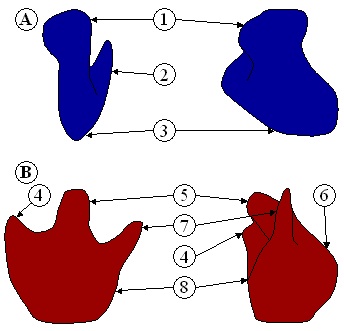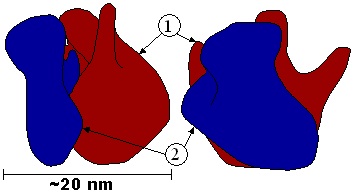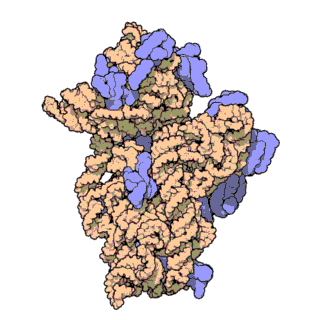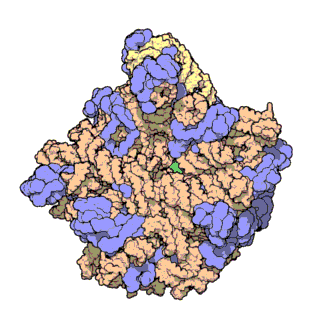Ribosome
Editor-In-Chief: C. Michael Gibson, M.S., M.D. [1]

(1) Head. (2) Platform. (3) Base. (4) Ridge. (5) Central protuberance. (6) Back. (7) Stalk. (8) Front.
Ribosomes (from ribonucleic acid and "greek: soma (meaning body)") are complexes of RNA and protein that are found in all cells. Prokaryotic ribosomes from archaea and bacteria are smaller than most of the ribosomes from eukaryotes such as plants and animals. However, the ribosomes in the mitochondrion of eukaryotic cells resemble those in bacteria, reflecting the evolutionary origin of this organelle.
The function of ribosomes is the assembly of proteins, in a process called translation. Ribosomes do this by catalysing the assembly of individual amino acids into polypeptide chains; this involves binding a messenger RNA and then using this as a template to join together the correct sequence of amino acids. This reaction uses adapters called transfer RNA molecules, which read the sequence of the messenger RNA and are attached to the amino acids.
Description
Ribosomes are about 20nm (200 Ångström) in diameter and are composed of 65% ribosomal RNA and 35% ribosomal proteins (known as a Ribonucleoprotein or RNP). They translate messenger RNA (mRNA) to build polypeptide chains (e.g., proteins) using amino acids delivered by transfer RNA (tRNA). Their active sites are made of RNA, so ribosomes are now classified as "ribozymes".[1]
Ribosomes build proteins from the genetic instructions held within messenger RNA. Free ribosomes are suspended in the cytosol (the semi-fluid portion of the cytoplasm); others are bound to the rough endoplasmic reticulum, giving it the appearance of roughness and thus its name, or to the nuclear envelope. As ribozymes, partly constituted from RNA, it is thought that they might be remnants of the RNA world.[2] Catalysis of the peptide bond involves the C2 hydroxyl of RNA's P-site adenosine in a protein shuttle mechanism. The full function (i.e. translocation) of the ribosome is reliant on changes in protein conformations. Ribosomes are sometimes referred to as organelles, but the use of the term organelle is contested and is falling from favor.
Ribosomes are an extremely important structure in the cell. Ribosomes were first observed in the mid-1950s by Romanian cell biologist George Palade using an electron microscope as dense particles or granules[3] for which he would win the Nobel Prize. The term "ribosome" was proposed by scientist Richard B. Roberts in 1958:
During the course of the symposium a semantic difficulty became apparent. To some of the participants, "microsomes" mean the ribonucleoprotein particles of the microsome fraction contaminated by other protein and lipid material; to others, the microsomes consist of protein and lipid contaminated by particles. The phrase “microsomal particles” does not seem adequate, and “ribonucleoprotein particles of the microsome fraction” is much too awkward. During the meeting the word "ribosome" was suggested; this seems a very satisfactory name, and it has a pleasant sound. The present confusion would be eliminated if “ribosome” were adopted to designate ribonucleoprotein particles in sizes ranging from 35 to 100S.
— Roberts, R. B., Microsomal Particles and Protein Synthesis[4]
The structure and function of the ribosomes and associated molecules, known as the translational apparatus, has been of research interest since the mid-twentieth century and is a very active field of study today.

Ribosomes consist of two subunits (Figure 1) that fit together (Figure 2) and work as one to translate the mRNA into a polypeptide chain during protein synthesis (Figure 3). Prokaryotic subunits consist of one or two and eukaryotic of one or three very large RNA molecules (known as ribosomal RNA or rRNA) and multiple smaller protein molecules. Crystallographic work has shown that there are no ribosomal proteins close to the reaction site for polypeptide synthesis. This suggests that the protein components of ribosomes act as a scaffold that may enhance the ability of rRNA to synthesize protein rather than directly participating in catalysis (See: Ribozyme).
Biogenesis
In prokaryotic cells, ribosomes synthesize with cytoplasm to enable the transcription of multiple ribosome gene operons. In eukaryotes and some prokaryotic cells, the process takes place both in the cell cytoplasm and in the nucleolus of eukaryotic cells. It involves the coordinated function of over 200 proteins in the synthesis and processing of the four rRNAs, as well as assembly of those rRNAs with the ribosomal proteins.
Ribosome locations
Ribosomes are classified as being either "free" or "membrane-bound".
Free ribosomes
Free ribosomes are "free" to move about anywhere in the cytoplasm (within the cell membrane). Proteins formed from free ribosomes are used within the cell. Proteins containing disulfide bonds using cysteine amino acids cannot be produced outside of the lumen of the endoplasmic reticulum.
Membrane-bound ribosomes
When certain proteins are synthesized by a ribosome they can become "membrane-bound". The newly produced polypeptide chains are inserted directly into the endoplasmic reticulum by the ribosome and are then transported to their destinations. Bound ribosomes usually produce proteins that are used within the cell membrane or are expelled from the cell via exocytosis.
Free and membrane-bound ribosomes differ only in their spatial distribution; they are identical in structure and function. Whether the ribosome exists in a free or membrane-bound state depends on the presence of a ER-targeting signal sequence on the protein being synthesized.
Structure

The ribosomal subunits of prokaryotes and eukaryotes are quite similar.[6]
Prokaryotes have 70S ribosomes, each consisting of a small (30S) and a large (50S) subunit. Their large subunit is composed of a 5S RNA subunit (consisting of 120 nucleotides), a 23S RNA subunit (2900 nucleotides) and 34 proteins. The 30S subunit has a 1540 nucleotide RNA subunit bound to 21 proteins.[6]
Eukaryotes have 80S ribosomes, each consisting of a small (40S) and large (60S) subunit. Their large subunit is composed of a 5S RNA (120 nucleotides), a 28S RNA (4700 nucleotides), a 5.8S subunit (160 nucleotides) and ~49 proteins. The 40S subunit has a 1900 nucleotide (18S) RNA and ~33 proteins.[6]
The ribosomes found in chloroplasts and mitochondria of eukaryotes also consist of large and small subunits bound together with proteins into one 70S particle.[6] These organelles are believed to be descendants of bacteria (see Endosymbiotic theory) and as such their ribosomes are similar to those of prokaryotes.[7]
The various ribosomes share a core structure which is quite similar despite the large differences in size. The extra RNA in the larger ribosomes is in several long continuous insertions, such that they form loops out of the core structure without disrupting or changing it.[6] All of the catalytic activity of the ribosome is carried out by the RNA, the proteins reside on the surface and seem to stabilize the structure.[6]
The differences between the prokaryotic and eukaryotic ribosomes are exploited by pharmaceutical chemists to create antibiotics that can destroy a bacterial infection without harming the cells of the infected person. Due to the differences in their structures, the bacterial 70S ribosomes are vulnerable to these antibiotics while the eukaryotic 80S ribosomes are not.[8] Even though mitochondria possess ribosomes similar to the bacterial ones, mitochondria are not affected by these antibiotics because they are surrounded by a double membrane that does not easily admit these antibiotics into the organelle.[9]
Atomic structure

The general molecular structure of the ribosome has been known since the early 1970s. In the early 2000s the structure has been achieved at high resolutions, in the order of a few Ångströms.
The first papers giving the structure of the ribosome at atomic resolution, were published in rapid succession in late 2000. First, the 50S (large prokaryotic) subunit from the archea, Haloarcula marismortui was published.[10] Soon after the structure of the 30S subunit from Thermus thermophilus was published.[5] Shortly thereafter a more detailed structure was published.[11] Early the next year (May 2001) these coordinates were used to reconstruct the entire T. thermophilus 70S particle at 5.5 Ångström resolution.[12]
Two papers were published in November 2005 with structures of the Escherichia coli 70S ribosome. The structures of vacant ribosome were determined at 3.5 Ångström resolution using x-ray crystallography.[13] Then, two weeks later, a structure based on cryo-electron microsopy was published,[14] which depicts the ribosome at 11-15 Ångström resolution in the act of passing a newly synthesized protein strand into the protein-conducting channel.
First atomic structures of the ribosome complexed with tRNA and mRNA molecules were solved by using X-ray crystallography by two groups independently, at 2.8 Ångström[15] and at 3.7 Ångström.[16] These structures allow one to see the details of interactions of the Thermus thermophilus ribosome with mRNA and with tRNAs bound at classical ribosomal sites. Interactions of the ribosome with long mRNAs containing Shine-Dalgarno sequences were visualized soon after that at 4.5 to 5.5 Ångström resolution.[17]
Function
Ribosomes are the workhorses of protein biosynthesis, the process of translating RNA into protein. The mRNA comprises a series of codons that dictate to the ribosome the sequence of the amino acids needed to make the protein. Using the mRNA as a template, the ribosome traverses each codon of the mRNA, pairing it with the appropriate amino acid. This is done using molecules of transfer RNA (tRNA) containing a complementary anticodon on one end and the appropriate amino acid on the other.
Protein synthesis begins at a start codon near the 5' end of the mRNA. The small ribosomal subunit, typically bound to a tRNA containing the amino acid methionine, binds to an AUG codon on the mRNA and recruits the large ribosomal subunit. The large ribosomal subunit contains three tRNA binding sites, designated A, P, and E. The A site binds an aminoacyl-tRNA (a tRNA bound to an amino acid); the P site binds a peptidyl-tRNA (a tRNA bound to the peptide being synthesized); and the E site binds a free tRNA before it exits the ribosome.

In Figure 3, both ribosomal subunits (small and large) assemble at the start codon (towards the 5' end of the mRNA). The ribosome uses tRNA which matches the current codon (triplet) on the mRNA to append an amino acid to the polypeptide chain. This is done for each triplet on the mRNA, while the ribosome moves towards the 3' end of the mRNA. Usually in bacterial cells, several ribosomes are working parallel on a single mRNA, forming what we call a polyribosome or polysome.
References
- ↑ Rodnina MV, Beringer M, Wintermeyer W (2007). "How ribosomes make peptide bonds". Trends Biochem. Sci. 32 (1): 20–6. doi:10.1016/j.tibs.2006.11.007. PMID 17157507.
- ↑ Cech T (2000). "Structural biology. The ribosome is a ribozyme". Science. 289 (5481): 878–9. PMID 10960319.
- ↑ G.E. Palade. (1955) "A small particulate component of the cytoplasm." J Biophys Biochem Cytol. Jan;1(1): pages 59-68. PMID 14381428
- ↑ Roberts, R. B., editor. (1958) "Introduction" in Microsomal Particles and Protein Synthesis. New York: Pergamon Press, Inc.
- ↑ 5.0 5.1 Schluenzen F, Tocilj A, Zarivach R, Harms J, Gluehmann M, Janell D, Bashan A, Bartels H, Agmon I, Franceschi F, Yonath A (2000). "Structure of functionally activated small ribosomal subunit at 3.3 angstroms resolution". Cell. 102 (5): 615–23. PMID 11007480.
- ↑ 6.0 6.1 6.2 6.3 6.4 6.5 The Molecular Biology of the Cell, fourth eddition. Brusce Alberts, et al. Garland Science (2002) pg. 342 ISBN 0-8153-3218-1
- ↑ The Molecular Biology of the Cell, fourth edition. Bruce Alberts, et al. Garland Science (2002) pg. 808 ISBN 0-8153-3218-1
- ↑ Recht MI, Douthwaite S, Puglisi JD (1999). "Basis for prokaryotic specificity of action of aminoglycoside antibiotics". EMBO J. 18 (11): 3133–8. PMID 10357824.
- ↑ O'Brien, T.W., The General Occurrence of 55S Ribosomes in Mammalian Liver Mitochondria. J. Biol. Chem., 245:3409 (1971).
- ↑ 10.0 10.1 Ban N, Nissen P, Hansen J, Moore P, Steitz T (2000). "A". Science. 289 (5481): 905–20. PMID 10937989.
- ↑ Wimberly BT, Brodersen DE, Clemons WM Jr, Morgan-Warren RJ, Carter AP, Vonrhein C, Hartsch T, Ramakrishnan V. Structure of the 30S ribosomal subunit. Nature. 2000 Sep 21;407(6802):327-39. PMID 11014182
- ↑ Yusupov MM, Yusupova GZ, Baucom A, Lieberman K, Earnest TN, Cate JH, Noller HF. Crystal structure of the ribosome at 5.5 Å resolution. Science. 2001 May 4;292(5518):883-96. Epub 2001 Mar 29. PMID 11283358
- ↑ Schuwirth BS, Borovinskaya MA, Hau CW, Zhang W, Vila-Sanjurjo A, Holton JM, Cate JH. Structures of the bacterial ribosome at 3.5 Ångström resolution. Science. 2005 Nov 4;310(5749):827-34. PMID 16272117
- ↑ Mitra K, Schaffitzel C, Shaikh T, Tama F, Jenni S, Brooks CL 3rd, Ban N, Frank J. Structure of the E. coli protein-conducting channel bound to a translating ribosome. Nature. 2005 Nov 17;438(7066):318-24. PMID 16292303
- ↑ Selmer, M., Dunham, C.M., Murphy, F.V IV, Weixlbaumer, A., Petry S., Kelley, A.C., Weir, J.R. and Ramakrishnan, V. (2006). Structure of the 70S ribosome complexed with mRNA and tRNA. Science , 313, 1935-1942. PMID 16959973
- ↑ Korostelev A, Trakhanov S, Laurberg M, Noller HF. Crystal structure of a 70S ribosome-tRNA complex reveals functional interactions and rearrangements. Cell. 2006 Sep 22;126(6):1065-77
- ↑ Yusupova G, Jenner L, Rees B, Moras D, Yusupov M. Structural basis for messenger RNA movement on the ribosome. Nature. 2006 Nov 16;444(7117):391-4
See also
External links
- 70S Ribosome Architecture Animation of a working ribosome. Requires the Chime browser plugin from this site (where registration is required).
- Lab computer simulates ribosome in motion
- Role of the Ribosome, Gwen V. Childs, copied here
- Molecule of the Month © RCSB Protein Data Bank:
Template:Organelles
Template:NCBI-scienceprimer
ar:ريبوسوم
bs:Ribozomi
bg:Рибозома
ca:Ribosoma
cs:Ribozom
cy:Ribosom
da:Ribosom
de:Ribosom
el:Ριβόσωμα
eo:Ribosomo
fa:ریبوزوم
fo:Ribosom
gl:Ribosoma
ko:리보솜
hr:Ribosomi
ia:Ribosoma
it:Ribosoma
he:ריבוזום
la:Ribosoma
lb:Ribosom
lt:Ribosoma
mk:Рибозом
ms:Ribosom
nl:Ribosoom
no:Ribosom
oc:Ribosòma
simple:Ribosome
sk:Ribozóm
sl:Ribosom
sr:Рибозом
sh:Ribozom
fi:Ribosomi
sv:Ribosom
th:ไรโบโซม
uk:Рибосома